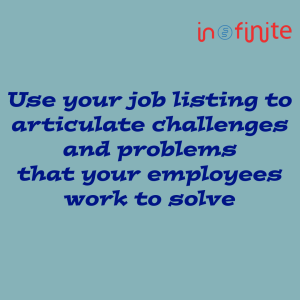The job listing is a fundamental tool in a company’s hiring process. It’s the starting point, the gateway to the actual work of bringing talented people into an organization. It’s important to get it right.
From early newspaper advertisements in the 17th century to the SEO-fueled posts on the internet here in the 21st century, the craft of the job listing has evolved to meet the needs of the marketplace. Much like the roles in most any company have changed to meet new technological and social demands, so too have the nuances of the job listing morphed over time to engage generations of workers.
Let’s take a close look at what that means for us in the modern world.
There is some basic information that every job listing must include. And then there are layers of different, innovative communications that can pepper a job listing and really make a company stand out in the eyes of a targeted labor market.
You need to explain what the job is, of course: the duties, the expectations, the compensation. But you must also use this opportunity to convey your company’s brand, culture, and aspirations. You must see the job listing as the first touchpoint for future employees (and, you’d better believe it, future customers). Don’t miss out.
Here are the basic elements of a successful job listing for executive-level roles:
Clear and Concise Job Title and Description
All right, this one might be obvious. But it’s also perhaps the most important aspect of your job listing. You’re not just writing a job title and description; you’re writing something clear and concise that will provide a detailed snapshot of what, exactly, is actually contained in the full explanation of the role.
Let’s say you run a law firm with your partners. You’d like to hire a paralegal. Well, you and every other law firm in your city are looking for the same type of person.
Take the job title one step further. Will this paralegal bear some project management responsibilities? (They usually do.) You might want to go ahead and include that in the title itself. Will this paralegal specialize in property law? Include that.
READY TO GET STARTED? GET IN TOUCH WITH THE IN-FINITE TEAM TODAY
Elaborate on that matter in the description. Again, be clear and concise. Workshop the description with the people who will work closely with this new hire. Be snappy with a detailed overview of the job (you can always expand on those details further in the listing) and try to include one unconventional duty that you’d like this paralegal to handle. You want to catch talented candidates’ eyes amidst a sea of Indeed and LinkedIn posts.
Company Culture and Values
Now that we’re getting into the heart of the job listing, make sure you expound on the company itself. This person is going to consider devoting the next chapter of their career to your organization, so what kind of culture propels this place?
Ideally, you can offer a detail-rich answer to that question right now as you’re reading this.. If not, take this moment to think about how your company culture (or, to continue the example, your law firm’s culture) might be communicated in writing. This is not necessarily easy, but it’s important.
Start by explicitly stating your firm’s values. These should be specific and clear. Expound briefly on each. Then share an overview of the actual tempo of the firm: Avoid the temptation to use ubiquitous terms like “collaborative, fast-paced, and innovative.” Instead, write from the heart. Explain the working environment in more detailed phrases, as though you were talking to this prospective candidate over a cup of coffee. Modify this description to ensure it’s as clear as possible.
Specific Qualifications and Experience
This portion of the job listing can efficiently be formatted in easy-to-read bullet points. You’re going to want specificity, and this section should do some good work in weeding out candidates that just aren’t a good fit for the role. So, once again, be clear and concise. List the most important qualifications that you’d like to see in your candidates: your must-haves.
Qualifications can include degrees, certifications, software expertise, foreign language fluency, legal compliance, and softer skills like experience with certain types of clients. Avoid jargon; just explain the sorts of capabilities needed to execute this role.
Note, too, if there’s a bit of flexibility here. Again, the more specific you can be, the better. But you’ll be casting a net into a diverse pool of candidates, and you want to be careful that you don’t eliminate a good fit before they’ve even applied.
Compensation and Benefits Information
There’s a familiar old chestnut that you see in most job listings: “competitive salary and benefits package.”
But that tells the candidate nothing.
Go ahead and differentiate your company by providing a clear-cut range of compensation for this role. On some level, you don’t want to get into the business of guaranteeing a specific salary for candidates sight-unseen, but you’d do well to explain where the conversation might begin.
Same with the benefits package: “Benefits” can mean a lot of things these days. While health insurance coverage and a retirement account match program are among the most common, companies can really get creative with enticements for employees. Make sure to clearly list those.
Application Process and Timeline
A job listing is by definition an invitation to a sequence of events: application, interview, negotiation, to put it simply. You should give prospective candidates a glimpse into how that process will work–and how much time might be required.
It helps to be clear about those expectations at the start. This shows a great deal of self-awareness, and prospective employees will take notice.
And here are some differentiating elements of a successful job listing for executive-level roles:
Compelling Storytelling
You’re not writing a novel or even a short story here, but you should incorporate some basic storytelling elements into your job listing. Paint a picture for your candidates. Allow them to imagine themselves working for your company or spending their time pursuing your team’s business goals.
If your founder is still involved in the firm, this might be an opportunity to include relevant biographical information about the origins of your organization (or link out to a landing page that provides the story).
Has the firm experienced a big win recently? Take a moment to highlight that, demonstrating how employees (like this prospective candidate reading your job listing) might have had a hand in that success. Provide a clear illustration of how people contribute to broader victories for the firm (and how that success redounds back to the individual employee).
Employee Testimonials or Success Stories
Remember that the hiring process is a broad-range opportunity to showcase your brand. That includes the job listing. You may as well use this prime real estate to show off a bit of what your existing team thinks about the company or even about their own experiences running the gauntlet of interviews way back when.
Throw in some punchy quotes from your top performers. If they’re willing to be contacted for an informational interview about the company, even better. This element will go a long way toward humanizing your listing and avoiding any of the more robotic terminology that fills the vast majority of job listings on the internet.
Unique Company Perks and Offerings
You’ve covered benefits, so now’s the time to dig in a bit deeper and convey a sense of how this company might change and uplift its employees’ lives and families. What are some of the more enriching perks of the firm?
Unlimited vacation policy? Country club membership? Student loan repayment matches? On-site wellness services?
Every firm is different, and this sort of cultural reward mechanism is a great way of showing how you and your team support your employees.
If you’re scratching your head as you read this particular section, now might be a good time to cook up some more intriguing perks for your existing team. Revisit this concept regularly.
Interactive or Multimedia Elements
There’s a fine line between compelling content and flashy content, so watch where you step here.
Depending on what sort of company we’re talking about, multimedia elements might fit in well with your job listing. This is certainly the case if you’re a video marketing agency. If you’re a law firm, well, like we said, tread lightly.

Insight Into Company Challenges and Goals
The job listing is typically a sunny place where no bad news hits the wire. But you don’t need to sugarcoat the whole thing. Prospects understand that part of what they’re signing up for when applying for new positions is a chance to solve complex problems and address deep-seated market challenges. Why not take a beat to explain what, exactly, those challenges are?
You can take a minute to look backward at previous challenges (and how your team surmounted them) or provide a look at existing goals that your prospective candidates will work to achieve. Don’t give away the whole plot, but you can helpfully describe the scenario into which employees will walk once they’re brought onboard. This section also provides meaningful information for impending interviews.
Here’s a bonus element that might make your job listing pop in a way that competing companies aren’t even considering:
Virtual Reality Tour
Depending on which industry you represent, a virtual reality tour of your office or facility might be a fascinating add-on for prospects who are willing to spend a little extra time with your listing. This can be especially true for those national executive searches: casting a broad net for a candidate who you’ll eventually fly in but who nevertheless are based somewhere far from wherever you’re currently located.
A VR tour can be a significant investment, maybe even over-the-top, but realize that for most future roles you can incorporate this material again and again. By the time your candidate has landed and arrived at your office for an interview, they’ll already be somewhat familiar with the setting. The VR tour can also be an opportunity to address the company’s relationship with innovative communications technology; is your company willing to invest in new, engaging software?
READY TO GET STARTED? GET IN TOUCH WITH THE IN-FINITE TEAM TODAY
INTERESTED IN THE IN-FINITE NEWSLETTER? SIGN UP BELOW >>>

